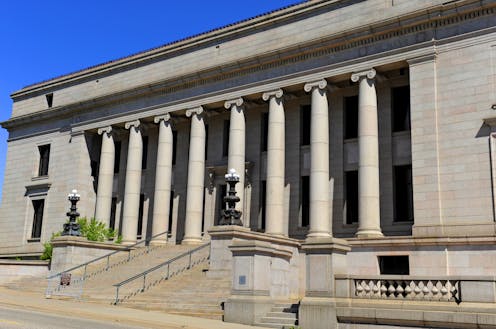In some states that say they elect judges, governors choose them instead
In 2 states with judicial elections − Georgia and Minnesota − nearly every justice steps down midterm, allowing the governor to appoint a successor instead of the state holding an open election.

State supreme court races have become pivotal in current legal battles over issues including abortion, elections, education, the environment and LGBTQ rights. With more than 80 state supreme court seats up for election this year in 33 states, voters have the potential to shape the future of their states for years to come.
That is, if they actually get to choose who joins the court.
Our research shows that in two states with judicial elections – Georgia and Minnesota – nearly every state supreme court justice steps down midterm, allowing the governor to appoint a successor instead of the state holding an open election for a new justice. This practice can at times place the governor at odds with the voters. It is also an incentive for governors, justices and other state officials to manipulate the process of judicial selection for partisan gain.
Election or governor’s choice?
The mechanics of selecting state supreme court justices vary throughout the country.
In the founding era, all states used gubernatorial or legislative appointments to select justices.
Elected judiciaries, including in Georgia and Minnesota, largely came about in the 1800s in response to concerns about appointed judges serving the interests of the governors and legislators who appointed them instead of those of the people. Later innovations included the use of nominating commissions that recruit and vet candidates and retention elections in which voters are asked to vote “yes” or “no” in an uncontested election on whether a judge should remain in office.
Today, 21 states initially select supreme court justices through popular elections. Another 26 states select justices through appointments, all with some form of check on the appointment power – either by means of a nominating commission, a confirmation vote by another elected body, or both.
New Mexico uses a hybrid system in which the governor appoints justices who then run in partisan elections, while South Carolina and Virginia select justices via legislative elections.
Georgia’s and Minnesota’s constitutions provide for nonpartisan elections to select and retain justices. Yet in practice, justices in both states have long been selected primarily through appointment by the governor.
Since 1980, for instance, all but three of the 25 justices to join the Georgia Supreme Court were appointed rather than elected, as were all but one of the 30 justices to join the Minnesota Supreme Court. Eight of Georgia’s nine current justices were appointed, and all seven of Minnesota’s current justices were appointed.
Continuing this tradition, two Minnesota justices this year are stepping down – one voluntarily, the other due to mandatory retirement. That allows Democratic-Farmer-Labor Gov. Tim Walz to appoint their replacements. Walz’s appointees first face elections in 2026.
Once appointed, they stay
Although appointees in Minnesota and Georgia face elections for subsequent terms, in practice, they stay until they choose to leave or face mandatory retirement. No incumbent Minnesota justice has lost an election since 1946, and no incumbent Georgia justice has lost an election in the court’s nearly 180-year history.
This ability of appointees to prevail in elections is a key factor in the states’ high rates of appointments. In contrast, in states like Ohio where incumbents lose more frequently, or in the two states where appointees cannot run for subsequent terms – Louisiana and Arkansas – more justices reach the bench via elections.
In addition to appointee win rates, many complex and interrelated factors influence the rate of appointments in states with judicial elections, none of which fully explains the practice in Georgia or Minnesota.
Are these appointments a problem?
As noted, many other states initially select their justices through appointments, and some scholars and policymakers argue that appointments are a better judicial selection method than elections.
But the practice can place the governor at odds with voters. For example, in 1992, Alan Page overwhelmingly won election to the Minnesota Supreme Court, making history as the first Black justice. Yet his win came only after two governors opposed his candidacy and sought to cancel elections that would have featured Page. Page successfully overcame the second governor’s effort and became the only justice since 1967 to be elected to the state’s high court.
Another concern is that, unlike other states that require selection through appointment, both Georgia and Minnesota lack explicit checks on the governor’s interim appointment power. Neither state requires a confirmation vote for appointees. And while several governors in each state have convened nominating commissions, they are not required to appoint someone the commission recommends.
Furthermore, as scholar Stephen Ware has written, the use of a nominating commission “all or mostly appointed by the governor hardly serves as a check on the governor.”
In reality, a similar concern is present even in some states that do have explicit limits on the governor’s appointment power. In Florida, for example, the governor has consolidated power over the state’s nominating commission, reducing its effectiveness as a check.
But it is notable that today no state has intentionally adopted a system of wholly unchecked gubernatorial appointment, like the de facto systems Georgia and Minnesota have implemented. This raises the question of whether Minnesota and Georgia voters would have adopted this system in their respective constitutions had they been asked.
Such unconstrained power can also contribute to partisan gamesmanship. In 2020, Republican-appointed Justice Keith Blackwell resigned from the Georgia Supreme Court just before the end of his term, allowing Republican Gov. Brian Kemp to appoint his successor. The Republican secretary of state then canceled the already-scheduled election for Blackwell’s seat, leading one commentator to describe these events as a “scheme to keep Blackwell’s seat in the GOP’s hands.”
As state supreme courts have the last word on an increasing number of high-profile disputes, this practice of substituting elections with appointments by a governor is increasingly consequential. With heightened spending on governors’ races aimed at influencing appointments to all levels of state courts, it is unclear whether other states will follow Georgia’s and Minnesota’s lead in moving to a de facto appointment system or, conversely, if they will maintain a greater role for the voice of the people.
The authors do not work for, consult, own shares in or receive funding from any company or organization that would benefit from this article, and have disclosed no relevant affiliations beyond their academic appointment.
Read These Next
2 superpowers, 1 playbook: Why Chinese and US bureaucrats think and act alike
The men and women tasked with implementing policy are governed by the same incentives and constraints…
How rogue nations are capitalizing on gaps in crypto regulation to finance weapons programs
North Korea was behind a $1.5 billion digital bank heist in February 2025. Other countries are similarly…
If tried by court-martial, senator accused of ‘seditious behavior’ would be deprived of several cons
US Sen. Mark Kelly correctly articulated military law when he said service members have a duty to not…





